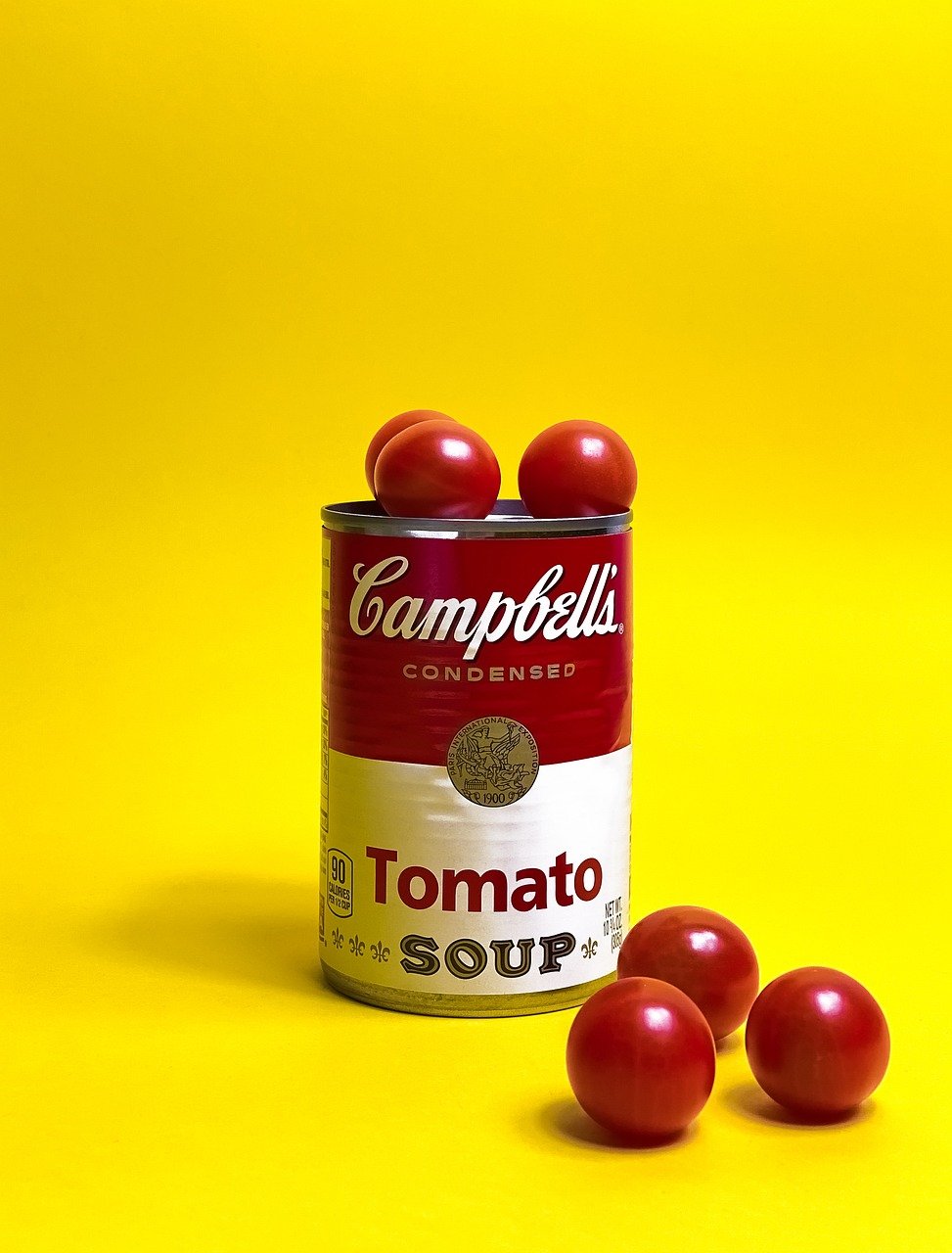
Can a simple, ordinary object we see every day, or perhaps a product we routinely put in our shopping trolley, become something extraordinary?
Pop Art, a movement that transformed how we perceive art in the 20th century, has shown us that even the most common objects can become works of art. Andy Warhol, one of the leading artists of this movement, elevated everyday objects, such as his famous Campbell’s Soup cans, to the status of cultural icons.
In fact, iconicity is not reserved only for celebrities of cinema or music, but can also be attributed to consumer products. This new artistic movement has shown how a repeated image, like Warhol’s soup cans, or a media icon, like Marilyn Monroe, can become universal symbols, celebrated and recognized worldwide.
Pop Art | Making art out of the ordinary
Numerous artists have understood and intercepted the pop charge possessed by certain consumer goods that surround us in our daily lives. The latter gave birth to the Pop Art movement during the economic boom.
If one wanted to give a precise date of birth to this artistic current, it would be August 8, 1956. When, at the Whitechapel Art Gallery in London, the exhibition This is Tomorrow opened. A great success with critics and the public, the exhibition explored the theme of consumer society and popular culture, consecrating the Pop Art movement. The latter would reach its peak in the following decade, in particular in the United Kingdom and the United States.
Pop Art ultimately challenges the traditional distinction between high and low culture. It does so by elevating consumer products, comics, and celebrities to artistic subjects. By abandoning canonical artistic techniques in favour of industrial processes. By using garish colours that reflect the tastes of consumer society and media. The aim is to look, with a neutral gaze, at mass culture. Elevating the mundane and ordinary to an art form.
Andy Warhol | The consecration of the pop object
Among the greatest exponents of American Pop Art is certainly Andy Warhol. A celebrated figure who shocked the art world with his innovative and provocative approach. Using screen printing, Andy Warhol transformed ordinary objects into the subjects of his works, often reiterating them over and over again, as if they were mass-produced.
It is possible, thus, to admire on his canvases the iconic outline of the Coca-Cola bottle. Or colourful detergent cans or even tins of tomato soup. Of course, not just any soup, but Campbell’s soup, popular in the United States, reproduced in Campbell’s Soup Cans (1963, MoMa, New York) thirty-two times. One for each taste. Again, in Green Coca-Cola Bottles (1962, Whitney Museum of American Art, New York), the world’s most famous drink appears a hundred and twelve times. Here Warhol combines silkscreen printing with traditional technique. By tracing the contours of the bottles by hand, so as to disturb the general regularity of the grid, he shows them, ambiguously, at once personalized and mass-produced.
Finally, Brillo Boxes (1964, Philadelphia Art Museum, Philadelphia) are sculptures that reproduce boxes containing metal sponges for washing dishes. Brillo brand. They embody the ordinariness of domestic life at a time when women, often homemakers, are exposed to advertising and consumer products that promise a flawless home and a perfect life.
Warhol’s Legacy | From Franco Moschino to Jeremy Scott
All these works show how simple everyday objects can become symbols of worship. How? By subverting the idea of painting as a medium of invention and originality. For while they satisfy the idea that art should imitate life, they also raise questions about how we identify and evaluate something as art.
This idea, which finds its zenith in the 1960s is, in fact, charged with the future. And not only in the world of art. Also in the world of fashion, which to this day is presented to us during fashion weeks.
When the fashion house Moschino launched its Fresh Couture perfume in 2015, it was clear what the cultural reference was. Just as Andy Warhol had turned a box of steel sponges into a work of art, Jeremy Scott, creative director of the Moschino fashion house at the time, turned glass-washing spray into a perfume.
Fresh Couture does, in fact, have packaging that echoes the packaging of household sprays. And it creates a jarring contrast between a luxurious haute couture fragrance and the most mundane of containers. Once again, there is a crasis between high culture and low culture. Once again, an everyday object becomes art, design, creativity. Jeremy Scott, after all, is merely taking up the lesson of the maison’s founder: Franco Moschino, a designer known for his irreverent, ironic and pop aesthetic.
Challenging fashion through provocation and satire
Moschino’s creations are distinguished by a bold use of color, a pounding “logo mania”, and the reprise on fabrics of iconic images and objects, often extrapolated from the world of mass consumption. His were not simply clothes. They were also posters that carried a critical and satirical message about fashion, the luxury industry, and the society of the time.
His advertising campaigns were also often provocative and playful. They challenged the traditional idea of how a luxury brand should approach the public, much like the work Warhol did in breaking down the barrier between art and mass culture. When the designer launched, for example, his first perfume, Moschino, in 1987, advertisements show a model drinking it through a straw. Next to it the words, “usage externe seulement !”
Looking back over the brand’s runway shows, it is not surprising, therefore, to find Coca-Cola cans turned into dresses. Or the huge M’s of MacDonald’s (or Moschino’s?) on bags, sunglasses and suits. Or again, comic book pages transformed into elegant evening gowns.
Ultimately, it is all about capturing the aesthetic potential of ordinary objects, showing that even the ordinary can become extraordinary. After all, as Andy Warhol said, “Don’t worry, there is nothing about art that one cannot understand.”







